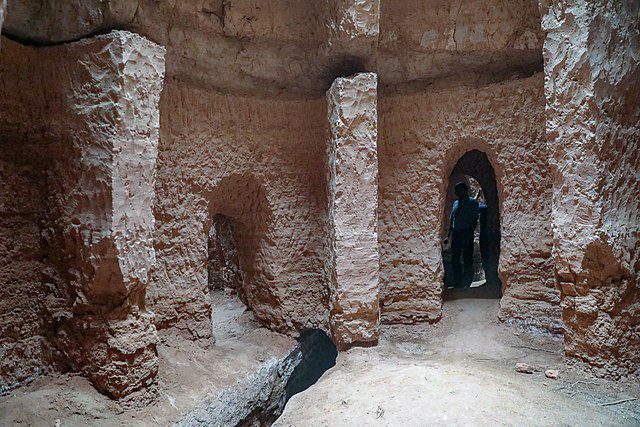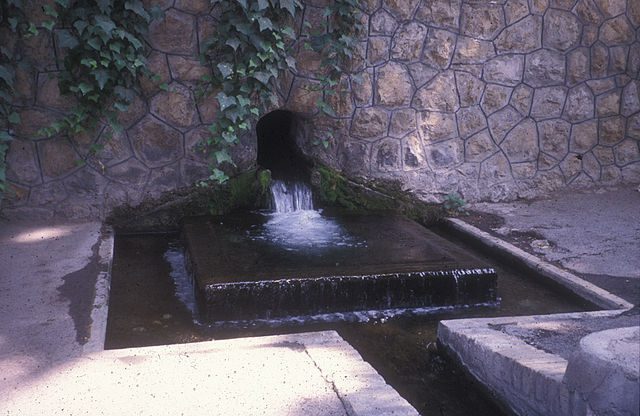Table of Contents
Qanat System: An Ancient Water System in the Heart of the Desert
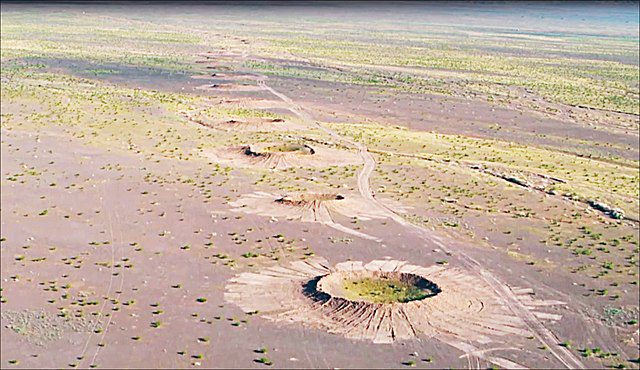
Qanat system (aka Kariz or aqueduct) is an underground water channel that transports water from the depths of the earth upstream to the surface of the earth downstream. The word Qanat is an Arabic word, but the Qanat water supply system has been invented in Iran.
Most parts of Iran are hot and dry. It is impossible to live in these areas without enough rain and running water, but the Iranians have been able to resolve their water needs and live in arid deserts by using qanats. That is the reason why in 2016, this ancient qanat system was inscribed in the UNESCO World Heritage Sites.
According to Iran’s Ministry of Energy, about 36,300 qanats have been identified in Iran. Qanat system was found in countries that were part of Iran or had cultural relations with Iran. There are qanats in Iraq and Syria, Pakistan and Afghanistan, western China, southern Russia, young countries in the Persian Gulf region, northern Africa, and southern Europe, but the number of qanats inside Iran alone is greater than the total number of them outside Iran.
Qanat Water Management System
Dive into the secrets beneath the Earth with the Qanat Water Management System—a super cool way people have been getting water for ages. Picture this: a tunnel, almost flat, picking up water from underground spots like alluvial fans. Right in the middle of this water-gathering maze is the “mother well,” smartly dug to hit just the right water level. Now, along this tunnel, there are wells spaced out like checkpoints. They’re not just holes; they’re there to clean up and let the air in, keeping the whole underground water dance going.
Take a journey below ground and discover how the Qanat Water Management System works like a water wizard. Instead of complicated pipes, it’s all about tunnels going side to side in the Earth. The water comes from underground fans, flowing to a main well in just the right spot. But it’s not just about getting there; it’s the adventure along the way. Imagine little wells popping up like secret doorways. They’re not just for show—they keep things fresh and tidy, making sure this ancient water plan keeps going strong.
The Oldest Qanats in Iran
Excavations in 2014 uncovered the remains of a Kariz near the Seimareh Dam, which dates back to the third millennium BC. In 2003, after the Bam earthquake, the qanat system Iran was discovered which is estimated to be more than 2,000 years old. The researches show that it was excavated in the late Achaemenid period. From the Achaemenid period onwards, the use of qanats became very popular. This was perhaps one of the victories of the Achaemenids against the Medes because they could use the qanat system to own agricultural lands and thus more people.
We also see the Achaemenids’ familiarity with tunnel-digging technology in military attacks. In their attacks on cities with defensive walls, the Achaemenids used to dig tunnels under the wall to gain access to the city or fortress. This type of military tunnel has been recorded in attacks on areas in Turkey and Cyprus.
Qanat Engineering
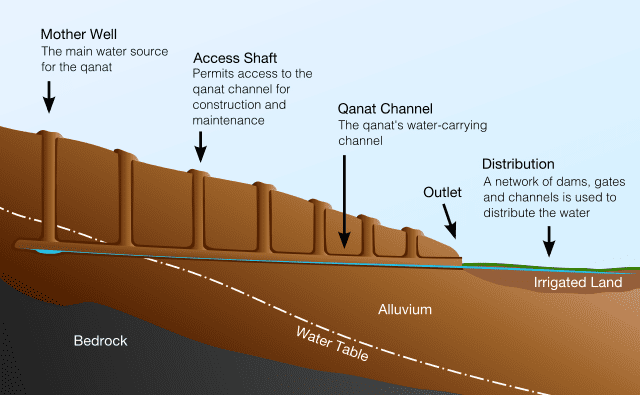
The first step is to identify the water upstream, which is usually located at the bottom of the mountain and the beginning of the plain. First, they test it by digging test wells to make sure it is stable. Then the Muqni (who is in charge of taking care of the qanats) begins digging the mother well of the qanat system. The mother well is usually one meter in diameter.
If they are lucky, they will reach water at a depth of fewer than 16 meters, but sometimes they will go down to a depth of 100 meters. Drilling should be done in the fall, which is the dry season, allowing the well to be drilled as deep as possible.
The next step after determining the location of the mother well is to calculate the route and slope of the qanat canal based on the location of the qanat outlet. If the slope is not calculated correctly, it may create muddy water or the water flow may cause corrosion and the qanat falls. Slope control is done by string and plumb line.
The next issue is determining the route. This was done by two oil lamps. From the ground, the path to the mother well is clear. Along this line, a string is placed on the ground. With a difference of one meter, two marks are made on this string, and a well is dug under these two marks.
After drilling the well to the calculated depth, the two oil lamps are measured exactly below. They have to align their drilling path with the lights. To do this, they look at the lights through the middle of the hallway with one eye. If the channel length is correct, they should see two lights on top of each other as a point. If the channel is deflected, the two lights are separated by two lights, and Muqni can figure out how to correct the path.
The quality of oxygen in the tunnel is controlled by the color of the oil lamp flame. Whenever the color of the flame is abnormal, the muqni leaves the tunnel to avoid suffocation. In this case, a vertical well is drilled into the channel being drilled to drain the gas.
Usually, a pool is built next to the exit of the qanat to hold the water of the qanat so that it can be used when necessary. In some cases, when the kariz water is used for agriculture, it is muddy so that it has less penetration into the ground and travels long distances. With this clever method, the volume of water wasted was reduced.
Qanat system of irrigation must be cleaned every year. In each spring, the Muqni (who is in charge of taking care of the qanats) measures the length of the qanat to solve its problems. In this case, the qanat can have thousands of years of discharge. There are Karizes in Iran that have been flowing for more than two thousand years. Meanwhile, the famous Roman watering systems have all become ancient artifacts.
Geographical Distribution of Qanats
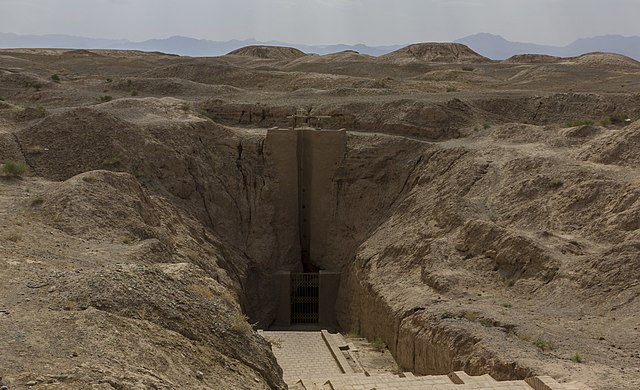
Qanat Iran is located in plains that are in the neighborhood of mountains. The water of the mountains is stored in the underground area next to the mountain and the inhabitants of the distant plains extract the stored water by the qanat. Qanat system can be seen everywhere in Iran, but most of them can be seen in the following plains: Tehran, Garmsar, Semnan, Shahroud, Sabzevar, Mashhad, Gonabad, Zarand, Isfahan, Kashan, Yazd, and Qazvin.
In these lands, where the annual rainfall is usually less than 300 mm per year, wheat and barley are widely cultivated, as well as summer crops, fruits, watermelons, melons, and vegetables. In the last decade, oilseeds and flaxseeds have also been cultivated. Despite the many dams and deep wells in recent years, qanats still provide an important part of agricultural water resources.
The length of such underground irrigation is very different and depends on the slope of the land and the distance of the village to the water source. This distance is less in lands with high slopes, because by digging a short horizontal tunnel in steep lands, we can reach a great depth of land very quickly, but in desert areas of Iran, qanats are longer. 70 km of qanats can be seen in Kerman and 30 to 40 km around Yazd. The Qazvin and Tehran qanats are rarely longer than 10 km. The average length of Isfahan aqueducts is 15 km.
10 Iranian Qanats Registered in the UNESCO World Heritage List
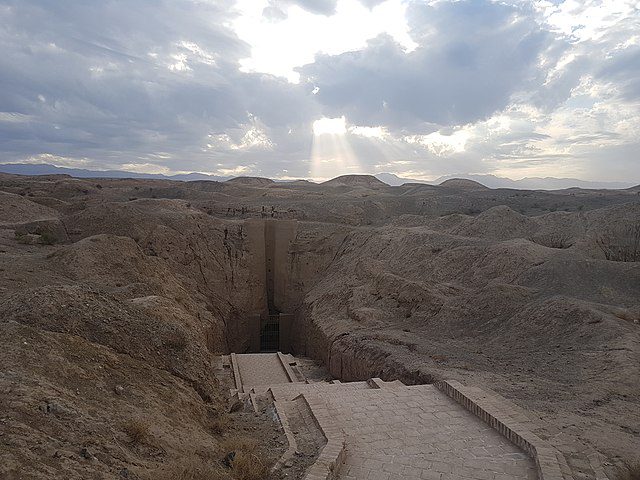
- Gonabad Qasbeh Qanat
- Balade Ferdows Qanat
- Zarch Garden Qanat in Yazd
- Hassanabad Mehriz qanat
- Mirzansarullah Mehriz Water Mill
- Goharriz Joopar Kerman Qanat
- Akbarabad and Qasemabad twin Qanats
- Moon Ardestan Qanat
- Vazvan Qanat in Meymeh, Isfahan
- Isfahan Mazdabad Qanat
Persian qanat is a symbol of the ancient and rich culture of Iran, which even today, with a history of several thousand years, is used in some parts of the country. This ancient water system is an amazing thing to visit in Iran.
FAQs about the Qanat System
Q1: What is a qanat system?
A1: A qanat, also known as a kārīz, is a way of bringing water from an underground source, like a well or aquifer, to the surface. This system started about 3,000 years ago in what is now Iran.
Q2: Are qanats still used today?
A2: Qanats are a smart water supply system created by ancient Persians about 3,000 years ago. In Farsi, they’re called kariz. This system spread to different parts of the world, and some are still in use today.
Q3: What is a qanat in geology?
A3: In simple terms, a qanat is like an underground pipe that moves fresh water from high-up mountains to a lower opening for irrigation. It’s a great solution in places with lots of mountains.
Q4: What does the term qanat refer to?
A4: It’s an underground water channel, often used in the Middle East, to move water from a source like an aquifer downhill using gravity, mainly for irrigation.
Q5: When was the qanat system invented
A5: Qanats likely started being developed around 2,500 to 3,000 years ago in Iran. The technology then spread to Afghanistan in the east and Egypt in the west. While not many new qanats are made today, the old ones are still actively used in Iran and Afghanistan, mainly for irrigation.
Last Words: Explore the Qanat System in Iran with a Customized Tour
The Qanat system, an ingenious ancient water management system dating back over a thousand years, is a testament to Iranian engineering and innovation. To fully appreciate its significance and beauty, a thoughtfully curated travel experience is essential.
To Iran Tour stands as a beacon for travelers eager to delve into the intricacies of Iran’s Qanat system while enjoying a personalized adventure. Whether you are captivated by history, fascinated by architecture, or drawn to the natural beauty surrounding the Qanats, To Iran Tour is here to ensure your journey is as unique as the wonders that await you in Iran.
Join us, and let’s embark on a personalized adventure that will leave you with a profound appreciation for Iran’s cultural heritage and the marvels of its Qanat system.

